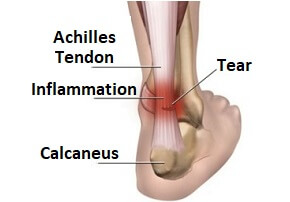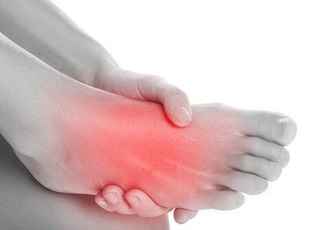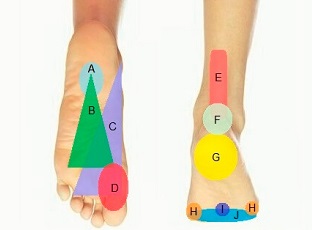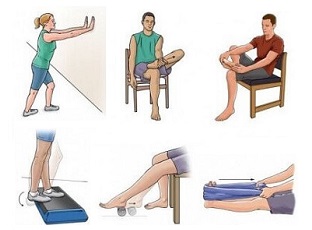- Home
- Common Foot Problems
- Tendonitis Guide
Foot & Ankle Tendonitis
Written By: Chloe Wilson BSc(Hons) Physiotherapy
Reviewed By: FPE Medical Review Board
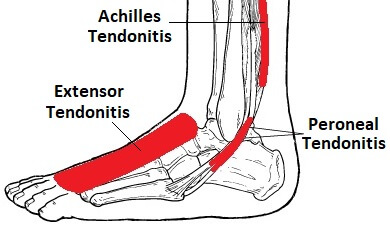
Foot and ankle tendonitis is a common cause of foot pain.
Tendonitis occurs when there is inflammation or irritation of the tendons, which is usually due to overuse from repetitive movements or stretching, or an injury such as an ankle sprain.
Symptoms of foot tendonitis typically consist of pain, swelling and stiffness. It usually takes two to three months to recover from ankle tendonitis, but it can take much longer without the proper treatment so early diagnosis and treatment is essential.
Foot and ankle tendonitis can affect any of the tendons in the foot.
Here we will look at how tendons get damaged and what the effects of that damage is. We will then go on to look at the most common types of foot and ankle tendonitis including the symptoms and treatment options for each.
What is Foot Tendonitis?
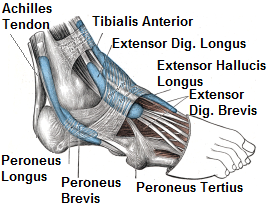
Tendons are the strong, cord-like bands of connective tissue that link muscles to bone. There are lots of different tendons around the foot that work hard whenever we are on our feet.
If a tendon is made to work too hard, for too long or in the wrong way, damage and tiny tears develop in the tendon. This is accompanied by inflammation which is the tell-tale sign of the condition.
The body’s normal response to an injury is to send extra red blood cells carrying the oxygen and nutrients required for healing and white cells to fight off possible infection. Waste products such as inflammatory chemicals are then carried away.
All of this helps speed up healing but should only last for a few days. If an area is repeatedly irritated, the process keeps going resulting in the continued inflammation described as tendonitis.
Causes Of Foot & Ankle Tendonitis
There are four main causes of foot and ankle tendonitis:
- Overuse: Tendonitis most commonly occurs when the tendon is repeatedly overloaded i.e. being asked to work too hard, or it is repeatedly over-stretched
- Abnormal Foot Structure: If your foot is an abnormal shape e.g. flat foot or high arches, it can put more stress on the tendons resulting in tendonitis
- Injury: Foot tendonitis can develop after any foot or ankle injury e.g. ligament sprain, or from repetitive friction on the tendon e.g. from a shoe rubbing
- Medical Conditions: Some inflammatory conditions such as gout and rheumatoid arthritis can cause foot and ankle tendonitis
Symptoms of Foot Tendonitis
The symptoms of foot and ankle tendonitis will vary according to the location, severity and stage of the tendonitis. The most common symptoms of foot and ankle tendonitis are:

- Foot Pain: Pain is usually the first sign that there is a problem. There tends to be a sharp and/or burning pain, usually localised to the area of the tendon at first but as the condition worsens, can spread wider.
Pain is usually worse with initial movement, settles down after a minute or so, but then returns as you do more. For example, your first few steps when you get out of bed will really hurt, but the pain will then ease up. But as you are on your feet for longer, the pain will return - Swelling: It usually takes a while for swelling to develop with the condition. After a few weeks of minor symptoms, you may notice a soft lump forming over the tendon, which is often tender to touch. This is most common in Achilles Tendonitis.
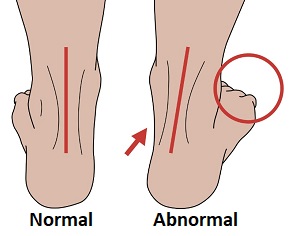
- Abnormal Foot Shape: Flat feet are often the result of a problem with the tibialis posterior. The tendon provides a majority of the support and stability for the inner foot arch.
When posterior tibial tendonitis develops, then the foot arch gradually collapses down. This then puts strain on other tendons in the foot so can cause inflammation and degeneration in those too - Stiffness: The foot and ankle often becomes stiff as a result of ankle tendonitis limiting the amount of pain-free movement.
Types of Foot and Ankle Tendonitis
Tendonitis can occur in a number of places around the foot and each will present with different symptoms.
1. Achilles Tendonitis
Achilles tendonitis causes heel and calf pain and is probably the most well known type of foot tendonitis.
The Achilles tendon joins the two calf muscles to the heel. Pain is usually felt when walking/running and can occur anywhere from the back of the heel up to the middle of the calf.
Find out more about the causes, symptoms, diagnosis and treatment options in the achilles tendonitis section.
2. Peroneal Tendonitis
Peroneal tendonitis causes pain on the back and outer side of your ankle/foot. The peroneal tendons run down the outer side of the ankle across the bottom of the foot.
Pain from peroneal tendonitis is usually felt when standing or pushing off through your foot.
You can find out loads more about the causes, symptoms, diagnosis and treatment options in the peroneal tendonitis article.
3. Posterior Tibial Tendonitis
Posterior tibial tendonitis causes pain on the inner side of the foot. The posterior tibial tendon runs along the inside of the foot and ankle.
Pain is usually felt when you start to push off through your foot. Over time, the foot arch will gradually collapse resulting in flat feet. The classic sign of posterior tibial tendonitis is an inability to stand on tiptoes.
You can find out loads more about the causes, symptoms, diagnosis and treatment options in the posterior tibial tendonitis section.
4. Extensor Tendonitis
Extensor tendonitis causes pain on the top of the foot. The extensor tendons job is to pull the toes up.
Pain from extensor tendonitis is often worse when running. This is one of the more rare types of ankle tendonitis.
You can find out loads more about the causes, symptoms, diagnosis and treatment options in the extensor tendonitis section.
5. Anterior Tibial Tendonitis
Anterior tibial tendonitis results in pain at the front of your foot. The Anterior Tibial Tendon controls the movement at the front of your foot.
Pain from anterior tibial tendonitis is usually felt when coming down stairs or when walking/running on sloped surfaces e.g. hills. Again, this is one of the less common places to get ankle tendonitis.
You can find out loads more about the causes, symptoms, diagnosis and treatment options in the tibialis anterior tendonitis section.
6. Sesamoiditis
Sesamoiditis is a type of foot tendonitis causing pain underneath the big toe.
With sesamoiditis, there is inflammation of the two small bones that sit underneath the big toe and the tendon that surrounds them, the flexor hallucis brevis tendon. This causes pain underneath the big toe and in the ball of the foot.
You can find out all about the causes, symptoms, diagnosis and treatment options in the Sesamoiditis section.
#CommissionEarned from Amazon on qualifying purchases
Foot & Ankle Tendonitis Treatment
Treatment for foot and ankle tendonitis typically consists of:
- PRICE: Protect, rest, ice, compression and elevation. This combination helps to reduce pain and inflammation in the foot and helps to speed up healing. LEARN MORE >
- Exercises: Strengthening and stretching exercises to address any areas of weakness and tightness. LEARN MORE >
- Avoid Aggravating Activities: It is really important not to do activities that aggravate your ankle tendonitis else it will not get the chance to repair itself
- Medication: painkillers e.g. paracetamol/acetaminophen and non-steroidal anti-inflammatories e.g. ibuprofen/Advil will help to reduce the pain and swelling associated with foot and ankle tendonitis
- Pain Relief Cream: there are various creams and gels that you can rub in to your foot that can really help to reduce foot and ankle tendonitis pain - the most popular ones are Tiger Balm and Arnica
- Orthotics: If abnormal foot positioning such as having flat feet is thought to be causing your tendonitis, then wearing special insoles in your shoes to help correct foot position can be a great way to treat ankle tendonitis. LEARN MORE >
- Walking Boot: In some cases of foot and ankle tendonitis you're doctor may recommend wearing a walking boot for a few weeks to help reduce the tension through the affected tendons. It means you can still walk around but the tendon gets more of a chance to rest and recover rather than being aggravated every time you walk
Specific treatment for foot and ankle tendonitis depends on which tendon is affected. You can find out loads more about the best treatment options for the different types of foot and ankle tendonitis:
- Achilles Tendonitis Treatment
- Peroneal Tendonitis Treatment
- Posterior Tibial Tendonitis Treatment
- Extensor Tendonitis Treatment
- Tibialis Anterior Tendonitis Treatment
- Sesamoiditis Treatment
Does Foot Tendonitis Ever Go Away?
In most cases, foot tendonitis will go away at some point. Recovery from any type of foot and ankle tendonitis tends to be slow and can take anything from weeks to months. The earlier treatment is started, the better the likely outcome.
For more in-depth information and specific treatment advice for each type of tendonitis, visit the appropriate section.
You may also be interested in the following articles:
- Top Of Foot Pain
- Pain On Side Of Foot
- Foot Arch Pain
- Foot Lumps & Bumps
- Burning Foot Pain
- Nerve Pain In Foot
- Foot Pain When Walking
Related Articles
Page Last Updated: 14th November, 2025
Next Review Due: 14th November, 2027
